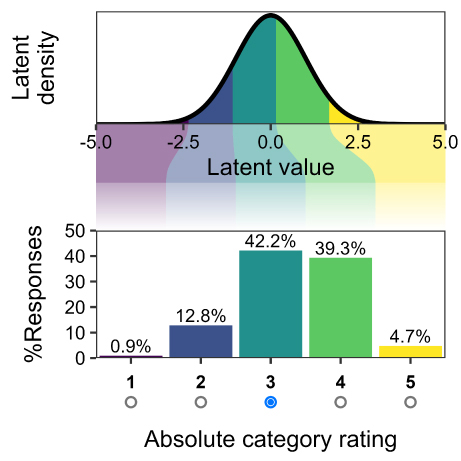References
1BampisC. G.KrasulaL.LiZ.AkhtarO.2023Measuring and predicting perceptions of video quality across screen sizes with crowdsourcing15th Int’l. Conf. Quality of Multimedia Experience (QoMEX)131813–8IEEEPiscataway, NJ10.1109/QoMEX58391.2023.10178501
2BürknerP.-C.2017BRMS: an R package for Bayesian multilevel models using StanJ. Stat. Software801281–28
3BürknerP.-C.VuorreM.2019Ordinal regression models in psychology: a tutorialAdv. Methods Pract. Psychol. Sci.27710177–101
4ChenC.LeeS.-Y.StevensonH. W.1995Response style and cross-cultural comparisons of rating scales among East Asian and North American studentsPsychol. Sci.6170175170–510.1111/j.1467-9280.1995.tb00327.x
5ChunK.-T.CampbellJ. B.YooJ. H.1974Extreme response style in cross-cultural research: a reminderJ. Cross-Cultural Psychol.5465480465–8010.1177/002202217400500407
6ClarkeI.III2000Extreme response style in cross-cultural research: an empirical investigationJ. Soc. Behav. Personality15137152137–52
7De JongM. G.SteenkampJ.-B. E.FoxJ.-P.BaumgartnerH.2008Using item response theory to measure extreme response style in marketing research: a global investigationJ. Mark. Res.45104115104–1510.1509/jmkr.45.1.104
8Del PinS. H.AmirshahiS. A.
9GreenleafE. A.1992Measuring extreme response stylePubl. Opinion Quart.56328351328–5110.1086/269326
10HoL. L.LohP. C.QuahA. L.
11HolbrookA. L.GreenM. C.KrosnickJ. A.2003Telephone versus face-to-face interviewing of national probability samples with long questionnaires: comparisons of respondent satisficing and social desirability response biasPubl. Opinion Quart.677912579–12510.1086/346010
12HosuV.LinH.SziranyiT.SaupeD.2020KonIQ-10k: an ecologically valid database for deep learning of blind image quality assessmentIEEE Trans. Image Process.29404140564041–5610.1109/TIP.2020.2967829
13HuiC. H.TriandisH. C.1989Effects of culture and response format on extreme response styleJ. Cross-cultural Psychol.20296309296–30910.1177/0022022189203004
14International Telecommunication UnionRecommendation ITU-R BT.500-15 (05/2023), Methodology for the subjective assessment of the quality of television pictures2023ITU Publications
15JanowskiL.PapirZ.2009Modeling subjective tests of quality of experience with a generalized linear modelFirst Int’l. Workshop on Quality of Multimedia Experience (QoMEX)354035–40IEEEPiscataway, NJ10.1109/QOMEX.2009.5246979
16JonesB. L.McManusP. R.1986Graphic scaling of qualitative termsSMPTE J.95116611711166–7110.5594/J04083
17KingmaD. P.BaJ.
18LiZ.BampisC. G.KrasulaL.JanowskiL.KatsavounidisI.2020A simple model for subject behavior in subjective experimentsIS&T Int’l. Symp. Electronic ImagingIS&TSpringfield, VA10.2352/ISSN.2470-1173.2020.11.HVEI-131
19LiddellT. M.KruschkeJ. K.2018Analyzing ordinal data with metric models: what could possibly go wrong?J. Exp. Soc. Psychol.79328348328–4810.1016/j.jesp.2018.08.009
20LinH.HosuV.SaupeD.2019KADID-10k: a large-scale artificially distorted IQA databaseEleventh Int’l. Conf. Quality of Multimedia Experience (QoMEX)131–3IEEEPiscataway, NJ10.1109/QoMEX.2019.8743252
21PinsonM. H.JanowskiL.PépionR.Huynh-ThuQ.SchmidmerC.CorriveauP.YounkinA.Le CalletP.BarkowskyM.IngramW.2012The influence of subjects and environment on audiovisual subjective tests: an international studyIEEE J. Sel. Top. Signal Process.6640651640–5110.1109/JSTSP.2012.2215306
22SaffirM. A.1937A comparative study of scales constructed by three psychophysical methodsPsychometrika2179198179–9810.1007/BF02288395
23SaupeD.Del PinS. H.2024National differences in image quality assessment: an investigation on three large-scale IQA datasets16th Int’l. Conf. Quality of Multimedia Experience (QoMEX)214220214–20IEEEPiscataway, NJ10.1109/QoMEX61742.2024.10598250
24SchönemannP. H.TuckerL. R.1967A maximum likelihood solution for the method of successive intervals allowing for unequal stimulus dispersionsPsychometrika32403417403–1710.1007/BF02289654
25ScottM. J.GuntukuS. C.HuanY.LinW.GhineaG.2015Modelling human factors in perceptual multimedia quality: on the role of personality and cultureProc. 23rd ACM Int’l. Conf. Multimedia481490481–90ACM PressNew York, NY10.1145/2733373.2806254
26SeufertM.2021Statistical methods and models based on quality of experience distributionsQual. User Exp.6310.1007/s41233-020-00044-z
27TasakaS.2017Bayesian hierarchical regression models for QoE estimation and prediction in audiovisual communicationsIEEE Trans. Multimedia19119512081195–20810.1109/TMM.2017.2652064
28TaylorJ. E.RousseletG. A.ScheepersC.SerenoS. C.2023Rating norms should be calculated from cumulative link mixed effects modelsBehav. Res. Methods55217521962175–9610.3758/s13428-022-01814-7
29TeunissenK.1996The validity of CCIR quality indicators along a graphical scaleSMPTE J.105144149144–910.5594/J04650
30ThurstoneL. L.1927A law of comparative judgmentPsychol. Rev.101273286273–8610.1037/h0070288
31TorgersonW. S.Theory and Methods of Scaling1958WileyNew York, NY
32WichmannF. A.HillN. J.2001The psychometric function: I. Fitting, sampling, and goodness of fitPercept. Psychophys.63129313131293–31310.3758/BF03194544
33XiangY.GubianS.SuomelaB.HoengJ.2013Generalized simulated annealing for efficient global optimization: the GenSA package for RR J.510.32614/RJ-2013-002
34ZaxM.TakahashiS.1967Cultural influences on response style: comparisons of Japanese and American college studentsJ. Soc. Psychol.713103–1010.1080/00224545.1967.9919760

 Find this author on Google Scholar
Find this author on Google Scholar Find this author on PubMed
Find this author on PubMed